Improving Organisational Culture and Employee Retention
VerifiedAdded on 2020/07/23
|9
|2480
|75
AI Summary
The assignment discusses the issues with organisational culture and employee retention at Imperial Hotel. It highlights the importance of improving supervision, making a collaborative culture, rewarding good consumer service, and providing constructive feedback. These strategies aim to decrease staff turnover rates and improve employee performance, leading to enhanced customer satisfaction.
Contribute Materials
Your contribution can guide someone’s learning journey. Share your
documents today.
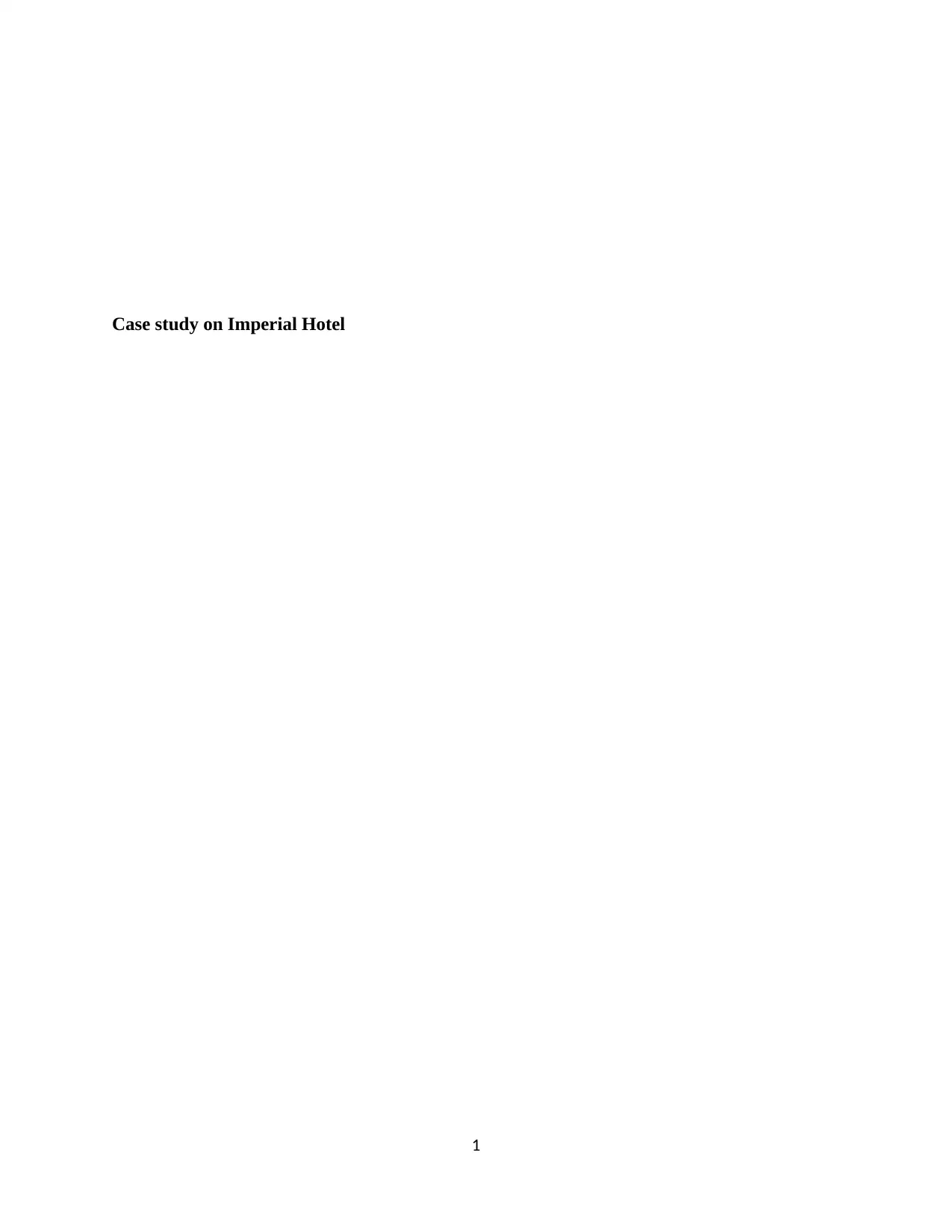
Case study on Imperial Hotel
1
1
Secure Best Marks with AI Grader
Need help grading? Try our AI Grader for instant feedback on your assignments.
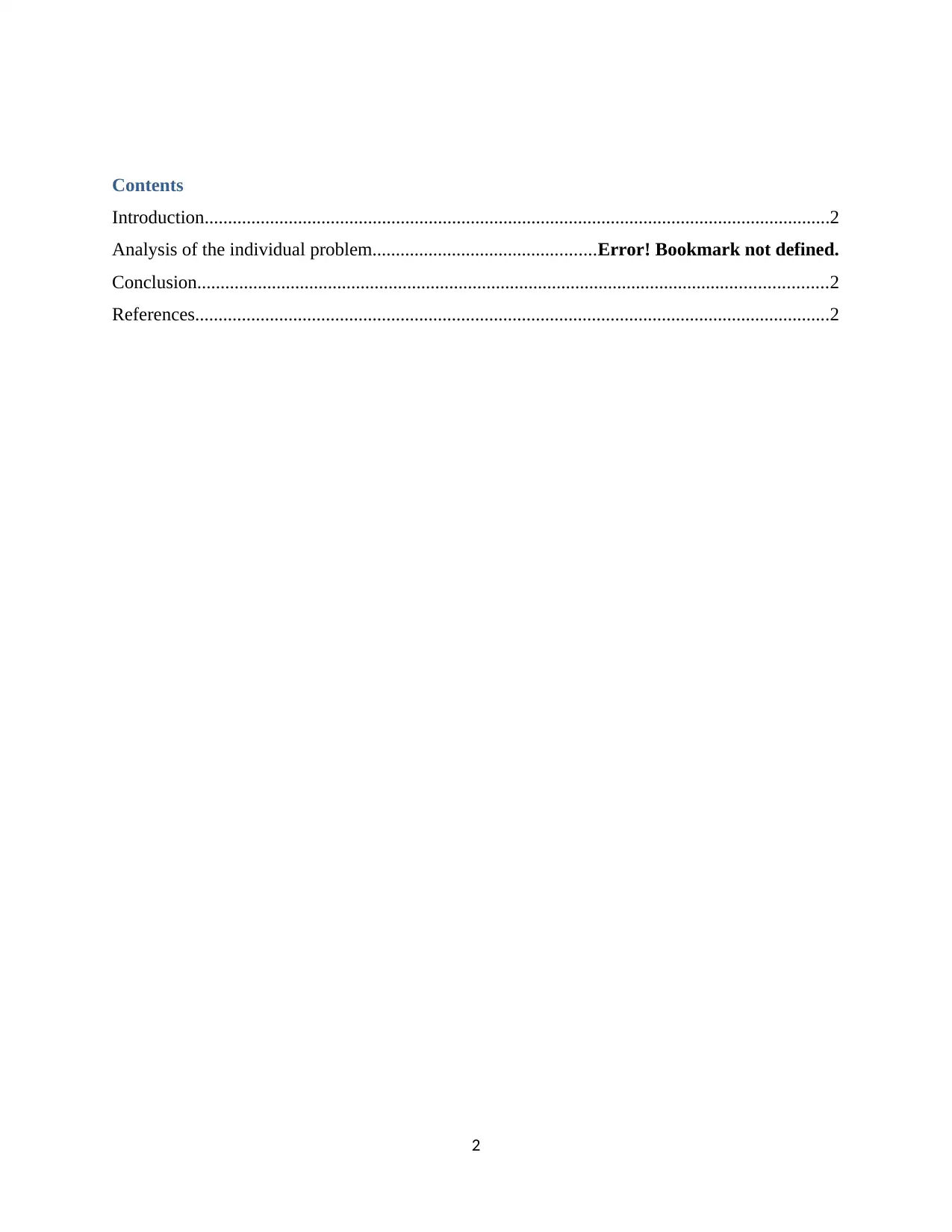
Contents
Introduction......................................................................................................................................2
Analysis of the individual problem................................................Error! Bookmark not defined.
Conclusion.......................................................................................................................................2
References........................................................................................................................................2
2
Introduction......................................................................................................................................2
Analysis of the individual problem................................................Error! Bookmark not defined.
Conclusion.......................................................................................................................................2
References........................................................................................................................................2
2
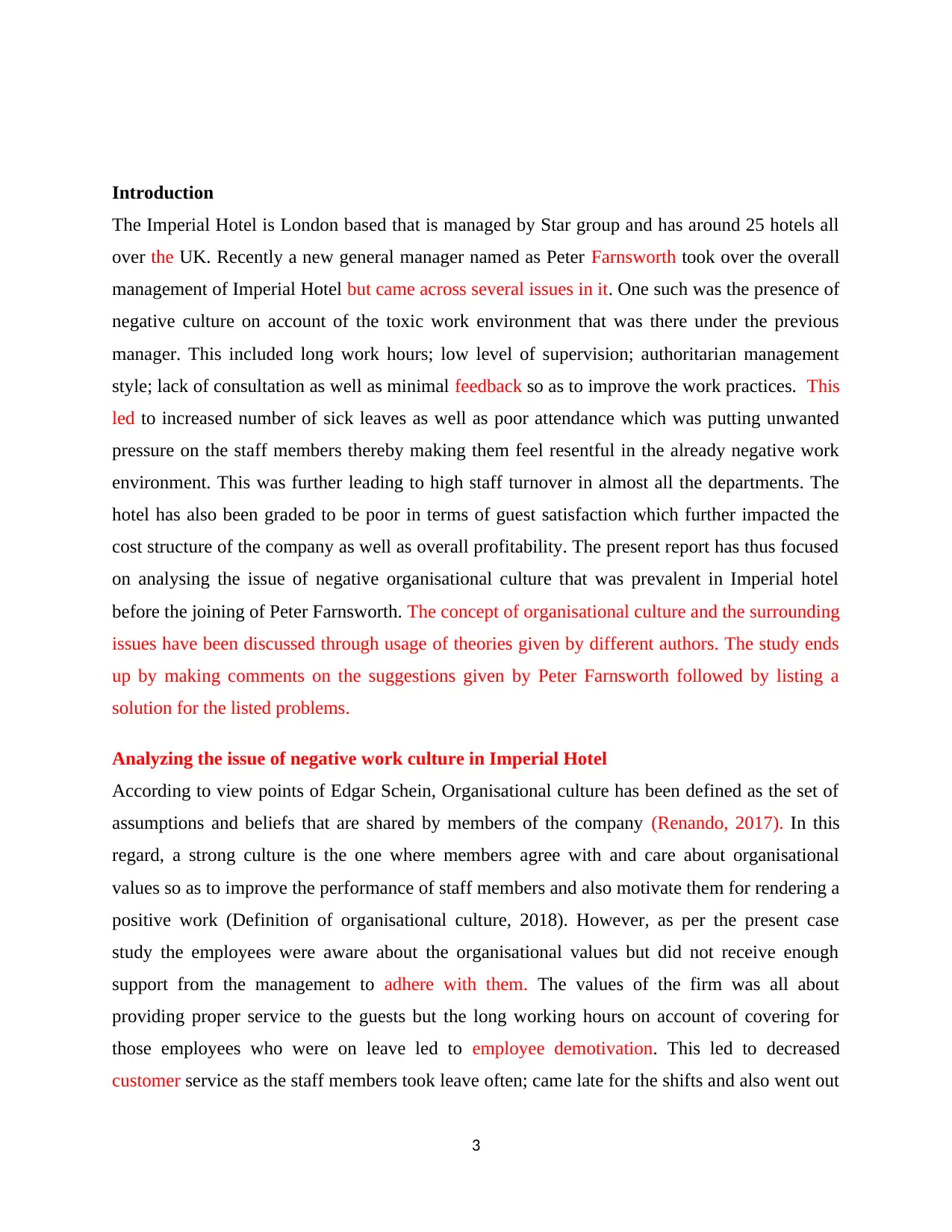
Introduction
The Imperial Hotel is London based that is managed by Star group and has around 25 hotels all
over the UK. Recently a new general manager named as Peter Farnsworth took over the overall
management of Imperial Hotel but came across several issues in it. One such was the presence of
negative culture on account of the toxic work environment that was there under the previous
manager. This included long work hours; low level of supervision; authoritarian management
style; lack of consultation as well as minimal feedback so as to improve the work practices. This
led to increased number of sick leaves as well as poor attendance which was putting unwanted
pressure on the staff members thereby making them feel resentful in the already negative work
environment. This was further leading to high staff turnover in almost all the departments. The
hotel has also been graded to be poor in terms of guest satisfaction which further impacted the
cost structure of the company as well as overall profitability. The present report has thus focused
on analysing the issue of negative organisational culture that was prevalent in Imperial hotel
before the joining of Peter Farnsworth. The concept of organisational culture and the surrounding
issues have been discussed through usage of theories given by different authors. The study ends
up by making comments on the suggestions given by Peter Farnsworth followed by listing a
solution for the listed problems.
Analyzing the issue of negative work culture in Imperial Hotel
According to view points of Edgar Schein, Organisational culture has been defined as the set of
assumptions and beliefs that are shared by members of the company (Renando, 2017). In this
regard, a strong culture is the one where members agree with and care about organisational
values so as to improve the performance of staff members and also motivate them for rendering a
positive work (Definition of organisational culture, 2018). However, as per the present case
study the employees were aware about the organisational values but did not receive enough
support from the management to adhere with them. The values of the firm was all about
providing proper service to the guests but the long working hours on account of covering for
those employees who were on leave led to employee demotivation. This led to decreased
customer service as the staff members took leave often; came late for the shifts and also went out
3
The Imperial Hotel is London based that is managed by Star group and has around 25 hotels all
over the UK. Recently a new general manager named as Peter Farnsworth took over the overall
management of Imperial Hotel but came across several issues in it. One such was the presence of
negative culture on account of the toxic work environment that was there under the previous
manager. This included long work hours; low level of supervision; authoritarian management
style; lack of consultation as well as minimal feedback so as to improve the work practices. This
led to increased number of sick leaves as well as poor attendance which was putting unwanted
pressure on the staff members thereby making them feel resentful in the already negative work
environment. This was further leading to high staff turnover in almost all the departments. The
hotel has also been graded to be poor in terms of guest satisfaction which further impacted the
cost structure of the company as well as overall profitability. The present report has thus focused
on analysing the issue of negative organisational culture that was prevalent in Imperial hotel
before the joining of Peter Farnsworth. The concept of organisational culture and the surrounding
issues have been discussed through usage of theories given by different authors. The study ends
up by making comments on the suggestions given by Peter Farnsworth followed by listing a
solution for the listed problems.
Analyzing the issue of negative work culture in Imperial Hotel
According to view points of Edgar Schein, Organisational culture has been defined as the set of
assumptions and beliefs that are shared by members of the company (Renando, 2017). In this
regard, a strong culture is the one where members agree with and care about organisational
values so as to improve the performance of staff members and also motivate them for rendering a
positive work (Definition of organisational culture, 2018). However, as per the present case
study the employees were aware about the organisational values but did not receive enough
support from the management to adhere with them. The values of the firm was all about
providing proper service to the guests but the long working hours on account of covering for
those employees who were on leave led to employee demotivation. This led to decreased
customer service as the staff members took leave often; came late for the shifts and also went out
3
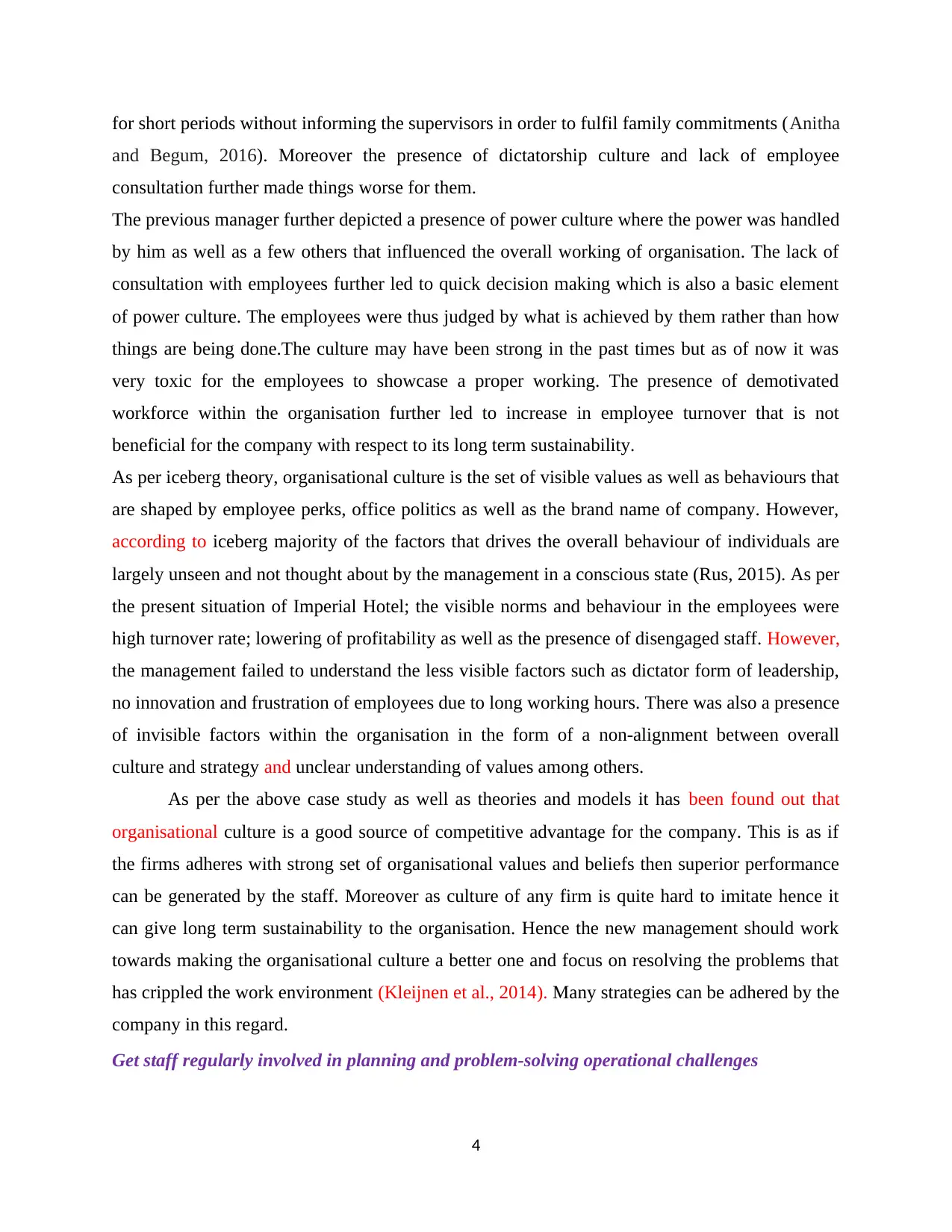
for short periods without informing the supervisors in order to fulfil family commitments (Anitha
and Begum, 2016). Moreover the presence of dictatorship culture and lack of employee
consultation further made things worse for them.
The previous manager further depicted a presence of power culture where the power was handled
by him as well as a few others that influenced the overall working of organisation. The lack of
consultation with employees further led to quick decision making which is also a basic element
of power culture. The employees were thus judged by what is achieved by them rather than how
things are being done.The culture may have been strong in the past times but as of now it was
very toxic for the employees to showcase a proper working. The presence of demotivated
workforce within the organisation further led to increase in employee turnover that is not
beneficial for the company with respect to its long term sustainability.
As per iceberg theory, organisational culture is the set of visible values as well as behaviours that
are shaped by employee perks, office politics as well as the brand name of company. However,
according to iceberg majority of the factors that drives the overall behaviour of individuals are
largely unseen and not thought about by the management in a conscious state (Rus, 2015). As per
the present situation of Imperial Hotel; the visible norms and behaviour in the employees were
high turnover rate; lowering of profitability as well as the presence of disengaged staff. However,
the management failed to understand the less visible factors such as dictator form of leadership,
no innovation and frustration of employees due to long working hours. There was also a presence
of invisible factors within the organisation in the form of a non-alignment between overall
culture and strategy and unclear understanding of values among others.
As per the above case study as well as theories and models it has been found out that
organisational culture is a good source of competitive advantage for the company. This is as if
the firms adheres with strong set of organisational values and beliefs then superior performance
can be generated by the staff. Moreover as culture of any firm is quite hard to imitate hence it
can give long term sustainability to the organisation. Hence the new management should work
towards making the organisational culture a better one and focus on resolving the problems that
has crippled the work environment (Kleijnen et al., 2014). Many strategies can be adhered by the
company in this regard.
Get staff regularly involved in planning and problem-solving operational challenges
4
and Begum, 2016). Moreover the presence of dictatorship culture and lack of employee
consultation further made things worse for them.
The previous manager further depicted a presence of power culture where the power was handled
by him as well as a few others that influenced the overall working of organisation. The lack of
consultation with employees further led to quick decision making which is also a basic element
of power culture. The employees were thus judged by what is achieved by them rather than how
things are being done.The culture may have been strong in the past times but as of now it was
very toxic for the employees to showcase a proper working. The presence of demotivated
workforce within the organisation further led to increase in employee turnover that is not
beneficial for the company with respect to its long term sustainability.
As per iceberg theory, organisational culture is the set of visible values as well as behaviours that
are shaped by employee perks, office politics as well as the brand name of company. However,
according to iceberg majority of the factors that drives the overall behaviour of individuals are
largely unseen and not thought about by the management in a conscious state (Rus, 2015). As per
the present situation of Imperial Hotel; the visible norms and behaviour in the employees were
high turnover rate; lowering of profitability as well as the presence of disengaged staff. However,
the management failed to understand the less visible factors such as dictator form of leadership,
no innovation and frustration of employees due to long working hours. There was also a presence
of invisible factors within the organisation in the form of a non-alignment between overall
culture and strategy and unclear understanding of values among others.
As per the above case study as well as theories and models it has been found out that
organisational culture is a good source of competitive advantage for the company. This is as if
the firms adheres with strong set of organisational values and beliefs then superior performance
can be generated by the staff. Moreover as culture of any firm is quite hard to imitate hence it
can give long term sustainability to the organisation. Hence the new management should work
towards making the organisational culture a better one and focus on resolving the problems that
has crippled the work environment (Kleijnen et al., 2014). Many strategies can be adhered by the
company in this regard.
Get staff regularly involved in planning and problem-solving operational challenges
4
Secure Best Marks with AI Grader
Need help grading? Try our AI Grader for instant feedback on your assignments.
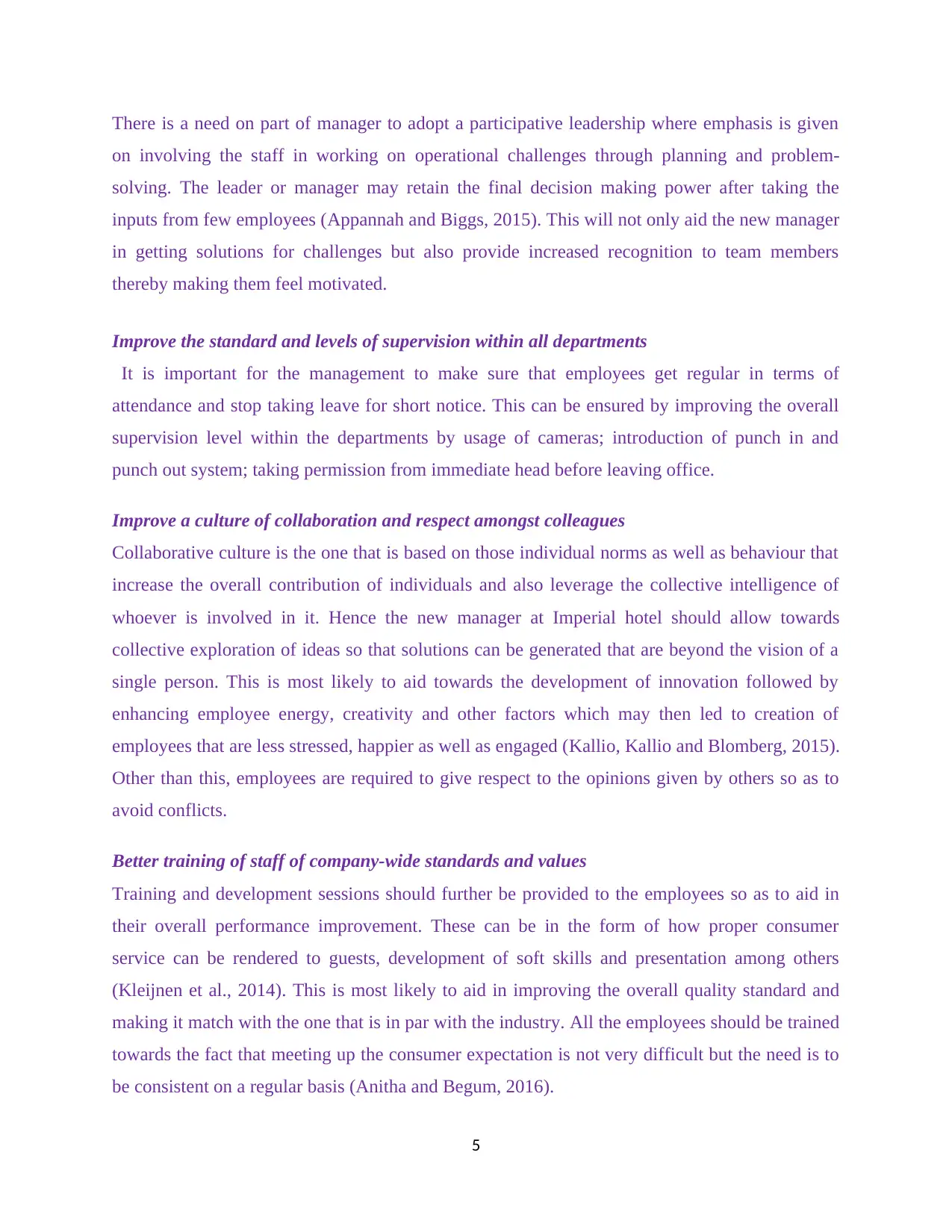
There is a need on part of manager to adopt a participative leadership where emphasis is given
on involving the staff in working on operational challenges through planning and problem-
solving. The leader or manager may retain the final decision making power after taking the
inputs from few employees (Appannah and Biggs, 2015). This will not only aid the new manager
in getting solutions for challenges but also provide increased recognition to team members
thereby making them feel motivated.
Improve the standard and levels of supervision within all departments
It is important for the management to make sure that employees get regular in terms of
attendance and stop taking leave for short notice. This can be ensured by improving the overall
supervision level within the departments by usage of cameras; introduction of punch in and
punch out system; taking permission from immediate head before leaving office.
Improve a culture of collaboration and respect amongst colleagues
Collaborative culture is the one that is based on those individual norms as well as behaviour that
increase the overall contribution of individuals and also leverage the collective intelligence of
whoever is involved in it. Hence the new manager at Imperial hotel should allow towards
collective exploration of ideas so that solutions can be generated that are beyond the vision of a
single person. This is most likely to aid towards the development of innovation followed by
enhancing employee energy, creativity and other factors which may then led to creation of
employees that are less stressed, happier as well as engaged (Kallio, Kallio and Blomberg, 2015).
Other than this, employees are required to give respect to the opinions given by others so as to
avoid conflicts.
Better training of staff of company-wide standards and values
Training and development sessions should further be provided to the employees so as to aid in
their overall performance improvement. These can be in the form of how proper consumer
service can be rendered to guests, development of soft skills and presentation among others
(Kleijnen et al., 2014). This is most likely to aid in improving the overall quality standard and
making it match with the one that is in par with the industry. All the employees should be trained
towards the fact that meeting up the consumer expectation is not very difficult but the need is to
be consistent on a regular basis (Anitha and Begum, 2016).
5
on involving the staff in working on operational challenges through planning and problem-
solving. The leader or manager may retain the final decision making power after taking the
inputs from few employees (Appannah and Biggs, 2015). This will not only aid the new manager
in getting solutions for challenges but also provide increased recognition to team members
thereby making them feel motivated.
Improve the standard and levels of supervision within all departments
It is important for the management to make sure that employees get regular in terms of
attendance and stop taking leave for short notice. This can be ensured by improving the overall
supervision level within the departments by usage of cameras; introduction of punch in and
punch out system; taking permission from immediate head before leaving office.
Improve a culture of collaboration and respect amongst colleagues
Collaborative culture is the one that is based on those individual norms as well as behaviour that
increase the overall contribution of individuals and also leverage the collective intelligence of
whoever is involved in it. Hence the new manager at Imperial hotel should allow towards
collective exploration of ideas so that solutions can be generated that are beyond the vision of a
single person. This is most likely to aid towards the development of innovation followed by
enhancing employee energy, creativity and other factors which may then led to creation of
employees that are less stressed, happier as well as engaged (Kallio, Kallio and Blomberg, 2015).
Other than this, employees are required to give respect to the opinions given by others so as to
avoid conflicts.
Better training of staff of company-wide standards and values
Training and development sessions should further be provided to the employees so as to aid in
their overall performance improvement. These can be in the form of how proper consumer
service can be rendered to guests, development of soft skills and presentation among others
(Kleijnen et al., 2014). This is most likely to aid in improving the overall quality standard and
making it match with the one that is in par with the industry. All the employees should be trained
towards the fact that meeting up the consumer expectation is not very difficult but the need is to
be consistent on a regular basis (Anitha and Begum, 2016).
5
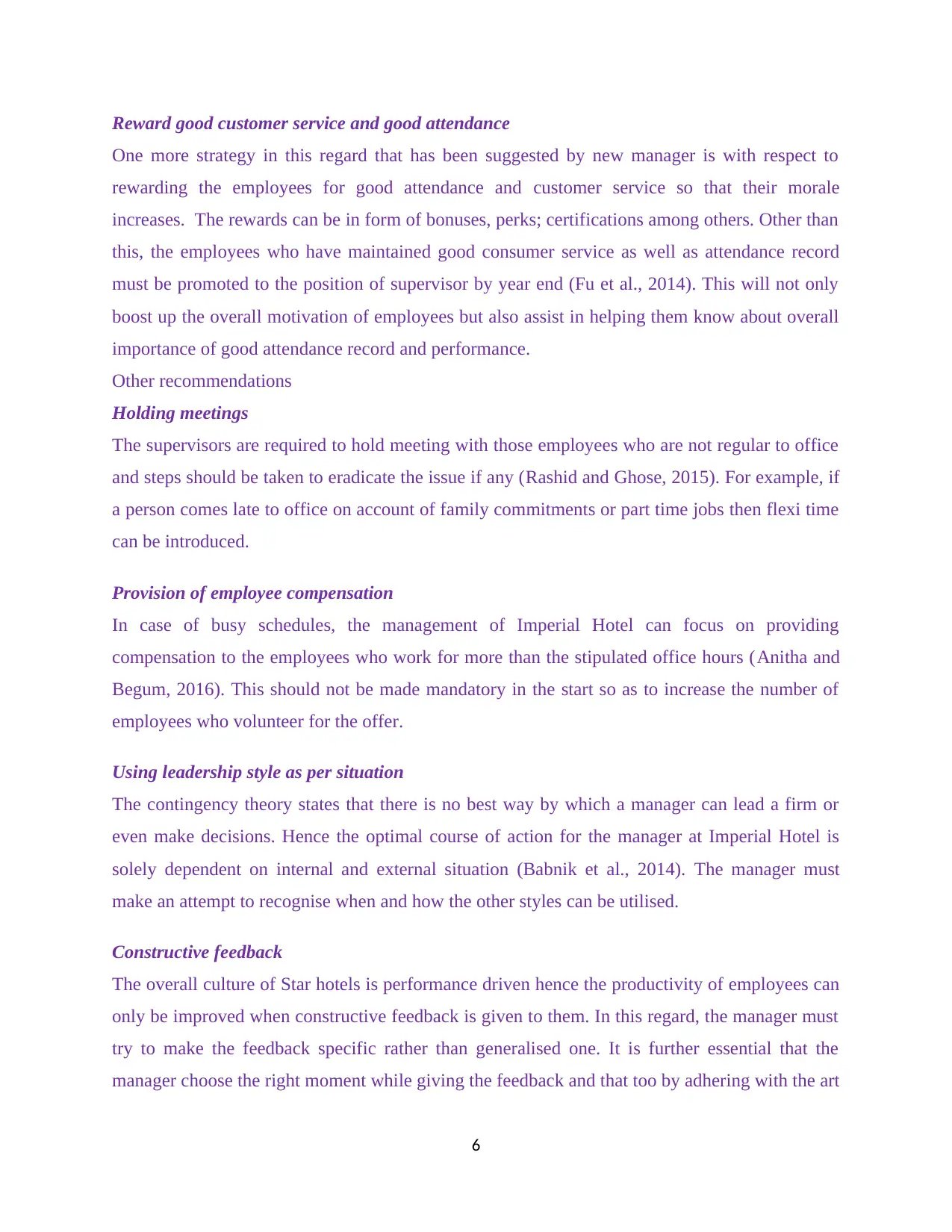
Reward good customer service and good attendance
One more strategy in this regard that has been suggested by new manager is with respect to
rewarding the employees for good attendance and customer service so that their morale
increases. The rewards can be in form of bonuses, perks; certifications among others. Other than
this, the employees who have maintained good consumer service as well as attendance record
must be promoted to the position of supervisor by year end (Fu et al., 2014). This will not only
boost up the overall motivation of employees but also assist in helping them know about overall
importance of good attendance record and performance.
Other recommendations
Holding meetings
The supervisors are required to hold meeting with those employees who are not regular to office
and steps should be taken to eradicate the issue if any (Rashid and Ghose, 2015). For example, if
a person comes late to office on account of family commitments or part time jobs then flexi time
can be introduced.
Provision of employee compensation
In case of busy schedules, the management of Imperial Hotel can focus on providing
compensation to the employees who work for more than the stipulated office hours (Anitha and
Begum, 2016). This should not be made mandatory in the start so as to increase the number of
employees who volunteer for the offer.
Using leadership style as per situation
The contingency theory states that there is no best way by which a manager can lead a firm or
even make decisions. Hence the optimal course of action for the manager at Imperial Hotel is
solely dependent on internal and external situation (Babnik et al., 2014). The manager must
make an attempt to recognise when and how the other styles can be utilised.
Constructive feedback
The overall culture of Star hotels is performance driven hence the productivity of employees can
only be improved when constructive feedback is given to them. In this regard, the manager must
try to make the feedback specific rather than generalised one. It is further essential that the
manager choose the right moment while giving the feedback and that too by adhering with the art
6
One more strategy in this regard that has been suggested by new manager is with respect to
rewarding the employees for good attendance and customer service so that their morale
increases. The rewards can be in form of bonuses, perks; certifications among others. Other than
this, the employees who have maintained good consumer service as well as attendance record
must be promoted to the position of supervisor by year end (Fu et al., 2014). This will not only
boost up the overall motivation of employees but also assist in helping them know about overall
importance of good attendance record and performance.
Other recommendations
Holding meetings
The supervisors are required to hold meeting with those employees who are not regular to office
and steps should be taken to eradicate the issue if any (Rashid and Ghose, 2015). For example, if
a person comes late to office on account of family commitments or part time jobs then flexi time
can be introduced.
Provision of employee compensation
In case of busy schedules, the management of Imperial Hotel can focus on providing
compensation to the employees who work for more than the stipulated office hours (Anitha and
Begum, 2016). This should not be made mandatory in the start so as to increase the number of
employees who volunteer for the offer.
Using leadership style as per situation
The contingency theory states that there is no best way by which a manager can lead a firm or
even make decisions. Hence the optimal course of action for the manager at Imperial Hotel is
solely dependent on internal and external situation (Babnik et al., 2014). The manager must
make an attempt to recognise when and how the other styles can be utilised.
Constructive feedback
The overall culture of Star hotels is performance driven hence the productivity of employees can
only be improved when constructive feedback is given to them. In this regard, the manager must
try to make the feedback specific rather than generalised one. It is further essential that the
manager choose the right moment while giving the feedback and that too by adhering with the art
6
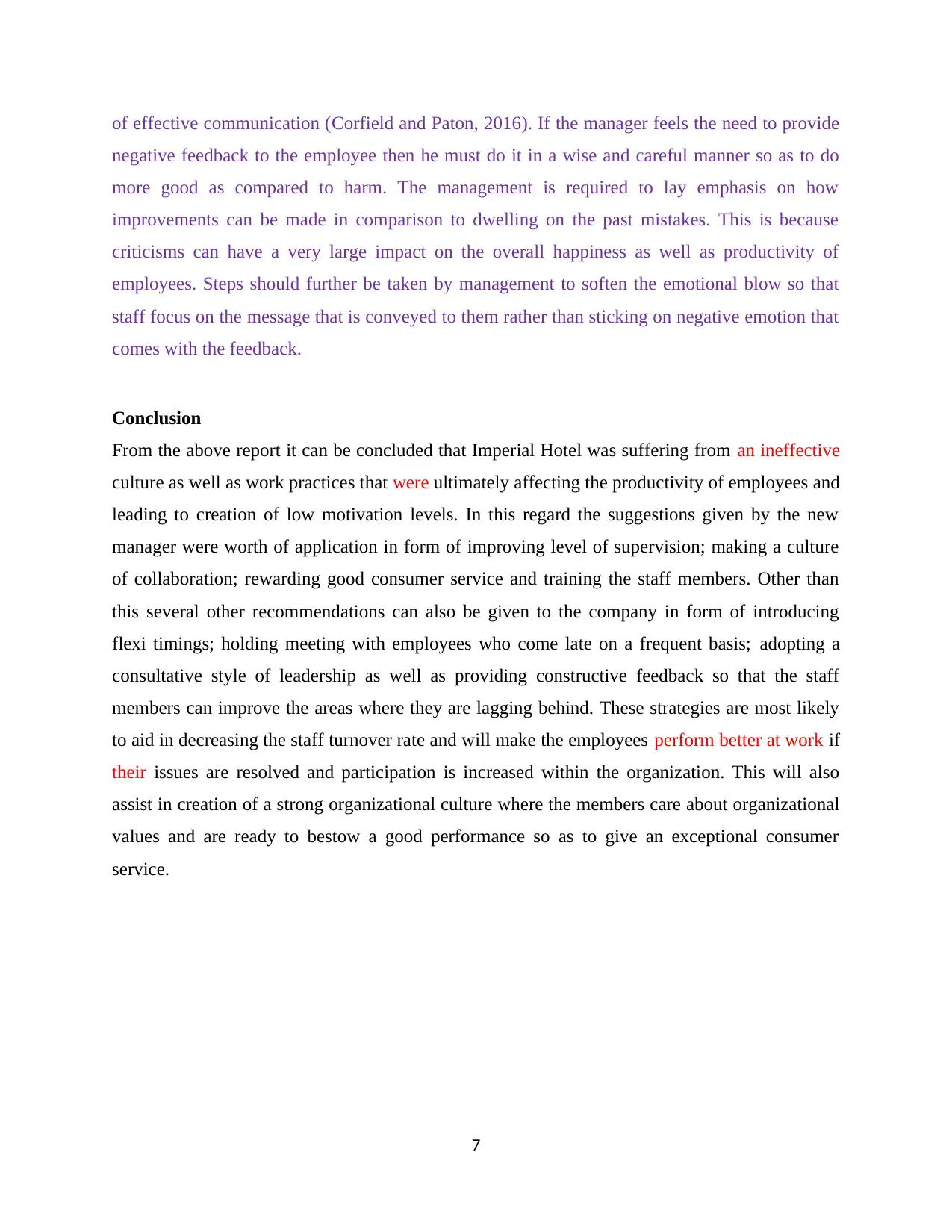
of effective communication (Corfield and Paton, 2016). If the manager feels the need to provide
negative feedback to the employee then he must do it in a wise and careful manner so as to do
more good as compared to harm. The management is required to lay emphasis on how
improvements can be made in comparison to dwelling on the past mistakes. This is because
criticisms can have a very large impact on the overall happiness as well as productivity of
employees. Steps should further be taken by management to soften the emotional blow so that
staff focus on the message that is conveyed to them rather than sticking on negative emotion that
comes with the feedback.
Conclusion
From the above report it can be concluded that Imperial Hotel was suffering from an ineffective
culture as well as work practices that were ultimately affecting the productivity of employees and
leading to creation of low motivation levels. In this regard the suggestions given by the new
manager were worth of application in form of improving level of supervision; making a culture
of collaboration; rewarding good consumer service and training the staff members. Other than
this several other recommendations can also be given to the company in form of introducing
flexi timings; holding meeting with employees who come late on a frequent basis; adopting a
consultative style of leadership as well as providing constructive feedback so that the staff
members can improve the areas where they are lagging behind. These strategies are most likely
to aid in decreasing the staff turnover rate and will make the employees perform better at work if
their issues are resolved and participation is increased within the organization. This will also
assist in creation of a strong organizational culture where the members care about organizational
values and are ready to bestow a good performance so as to give an exceptional consumer
service.
7
negative feedback to the employee then he must do it in a wise and careful manner so as to do
more good as compared to harm. The management is required to lay emphasis on how
improvements can be made in comparison to dwelling on the past mistakes. This is because
criticisms can have a very large impact on the overall happiness as well as productivity of
employees. Steps should further be taken by management to soften the emotional blow so that
staff focus on the message that is conveyed to them rather than sticking on negative emotion that
comes with the feedback.
Conclusion
From the above report it can be concluded that Imperial Hotel was suffering from an ineffective
culture as well as work practices that were ultimately affecting the productivity of employees and
leading to creation of low motivation levels. In this regard the suggestions given by the new
manager were worth of application in form of improving level of supervision; making a culture
of collaboration; rewarding good consumer service and training the staff members. Other than
this several other recommendations can also be given to the company in form of introducing
flexi timings; holding meeting with employees who come late on a frequent basis; adopting a
consultative style of leadership as well as providing constructive feedback so that the staff
members can improve the areas where they are lagging behind. These strategies are most likely
to aid in decreasing the staff turnover rate and will make the employees perform better at work if
their issues are resolved and participation is increased within the organization. This will also
assist in creation of a strong organizational culture where the members care about organizational
values and are ready to bestow a good performance so as to give an exceptional consumer
service.
7
Paraphrase This Document
Need a fresh take? Get an instant paraphrase of this document with our AI Paraphraser
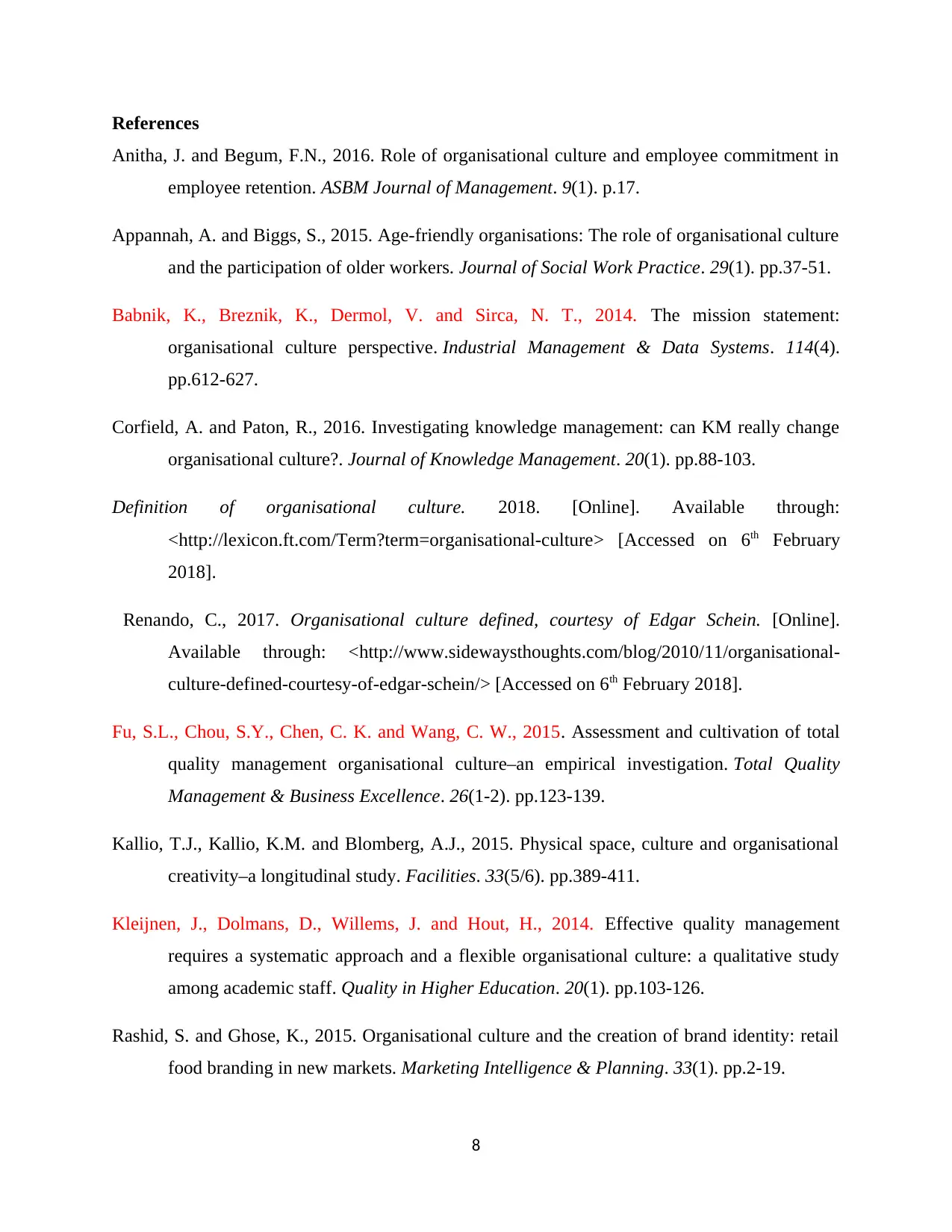
References
Anitha, J. and Begum, F.N., 2016. Role of organisational culture and employee commitment in
employee retention. ASBM Journal of Management. 9(1). p.17.
Appannah, A. and Biggs, S., 2015. Age-friendly organisations: The role of organisational culture
and the participation of older workers. Journal of Social Work Practice. 29(1). pp.37-51.
Babnik, K., Breznik, K., Dermol, V. and Sirca, N. T., 2014. The mission statement:
organisational culture perspective. Industrial Management & Data Systems. 114(4).
pp.612-627.
Corfield, A. and Paton, R., 2016. Investigating knowledge management: can KM really change
organisational culture?. Journal of Knowledge Management. 20(1). pp.88-103.
Definition of organisational culture. 2018. [Online]. Available through:
<http://lexicon.ft.com/Term?term=organisational-culture> [Accessed on 6th February
2018].
Renando, C., 2017. Organisational culture defined, courtesy of Edgar Schein. [Online].
Available through: <http://www.sidewaysthoughts.com/blog/2010/11/organisational-
culture-defined-courtesy-of-edgar-schein/> [Accessed on 6th February 2018].
Fu, S.L., Chou, S.Y., Chen, C. K. and Wang, C. W., 2015. Assessment and cultivation of total
quality management organisational culture–an empirical investigation. Total Quality
Management & Business Excellence. 26(1-2). pp.123-139.
Kallio, T.J., Kallio, K.M. and Blomberg, A.J., 2015. Physical space, culture and organisational
creativity–a longitudinal study. Facilities. 33(5/6). pp.389-411.
Kleijnen, J., Dolmans, D., Willems, J. and Hout, H., 2014. Effective quality management
requires a systematic approach and a flexible organisational culture: a qualitative study
among academic staff. Quality in Higher Education. 20(1). pp.103-126.
Rashid, S. and Ghose, K., 2015. Organisational culture and the creation of brand identity: retail
food branding in new markets. Marketing Intelligence & Planning. 33(1). pp.2-19.
8
Anitha, J. and Begum, F.N., 2016. Role of organisational culture and employee commitment in
employee retention. ASBM Journal of Management. 9(1). p.17.
Appannah, A. and Biggs, S., 2015. Age-friendly organisations: The role of organisational culture
and the participation of older workers. Journal of Social Work Practice. 29(1). pp.37-51.
Babnik, K., Breznik, K., Dermol, V. and Sirca, N. T., 2014. The mission statement:
organisational culture perspective. Industrial Management & Data Systems. 114(4).
pp.612-627.
Corfield, A. and Paton, R., 2016. Investigating knowledge management: can KM really change
organisational culture?. Journal of Knowledge Management. 20(1). pp.88-103.
Definition of organisational culture. 2018. [Online]. Available through:
<http://lexicon.ft.com/Term?term=organisational-culture> [Accessed on 6th February
2018].
Renando, C., 2017. Organisational culture defined, courtesy of Edgar Schein. [Online].
Available through: <http://www.sidewaysthoughts.com/blog/2010/11/organisational-
culture-defined-courtesy-of-edgar-schein/> [Accessed on 6th February 2018].
Fu, S.L., Chou, S.Y., Chen, C. K. and Wang, C. W., 2015. Assessment and cultivation of total
quality management organisational culture–an empirical investigation. Total Quality
Management & Business Excellence. 26(1-2). pp.123-139.
Kallio, T.J., Kallio, K.M. and Blomberg, A.J., 2015. Physical space, culture and organisational
creativity–a longitudinal study. Facilities. 33(5/6). pp.389-411.
Kleijnen, J., Dolmans, D., Willems, J. and Hout, H., 2014. Effective quality management
requires a systematic approach and a flexible organisational culture: a qualitative study
among academic staff. Quality in Higher Education. 20(1). pp.103-126.
Rashid, S. and Ghose, K., 2015. Organisational culture and the creation of brand identity: retail
food branding in new markets. Marketing Intelligence & Planning. 33(1). pp.2-19.
8
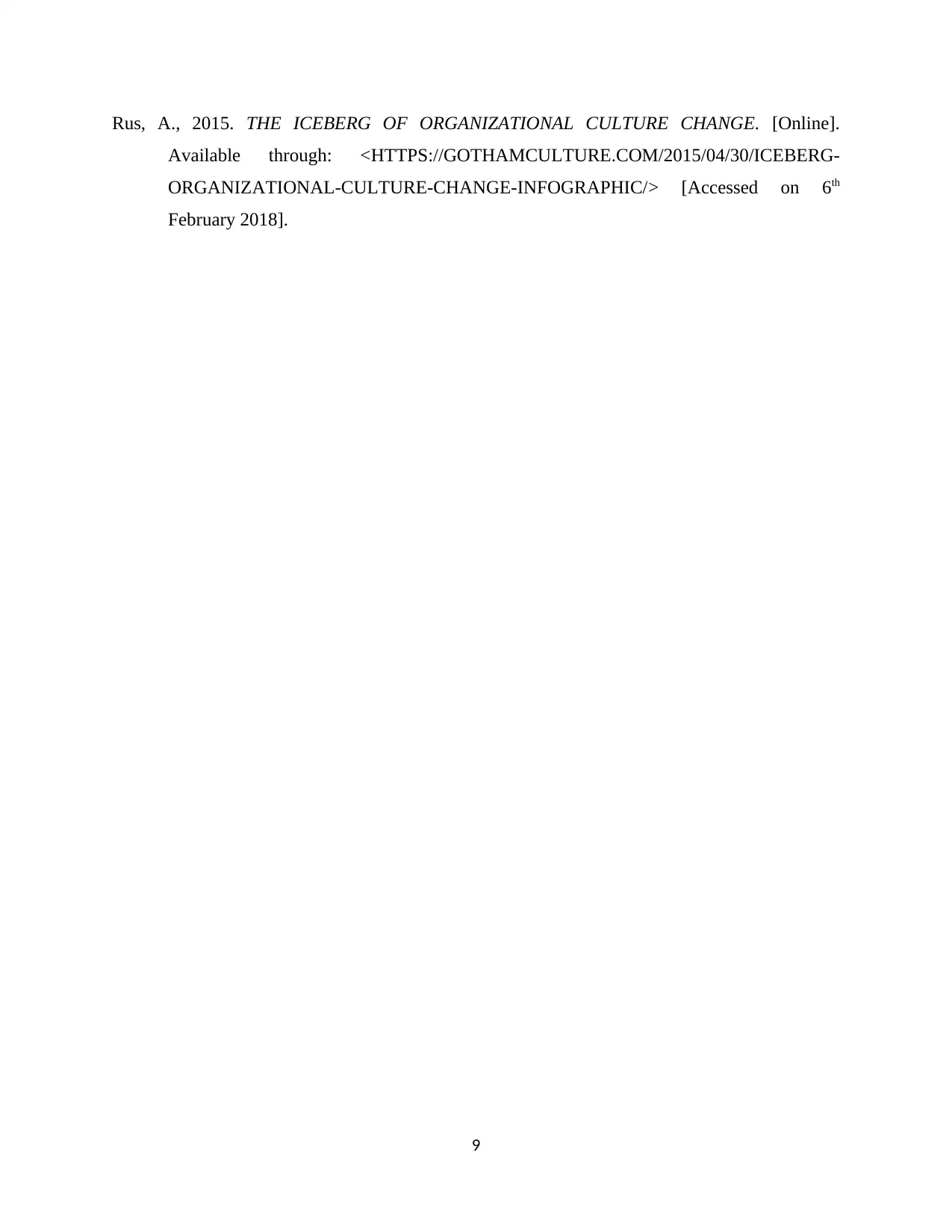
Rus, A., 2015. THE ICEBERG OF ORGANIZATIONAL CULTURE CHANGE. [Online].
Available through: <HTTPS://GOTHAMCULTURE.COM/2015/04/30/ICEBERG-
ORGANIZATIONAL-CULTURE-CHANGE-INFOGRAPHIC/> [Accessed on 6th
February 2018].
9
Available through: <HTTPS://GOTHAMCULTURE.COM/2015/04/30/ICEBERG-
ORGANIZATIONAL-CULTURE-CHANGE-INFOGRAPHIC/> [Accessed on 6th
February 2018].
9
1 out of 9
Related Documents
Your All-in-One AI-Powered Toolkit for Academic Success.
+13062052269
info@desklib.com
Available 24*7 on WhatsApp / Email
![[object Object]](/_next/static/media/star-bottom.7253800d.svg)
Unlock your academic potential
© 2024 | Zucol Services PVT LTD | All rights reserved.





